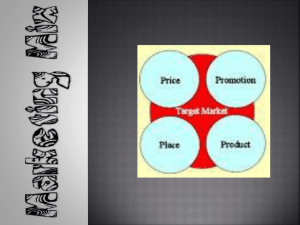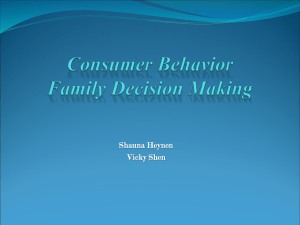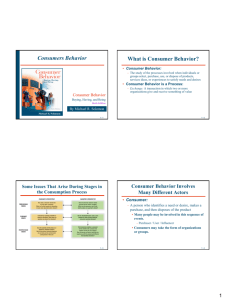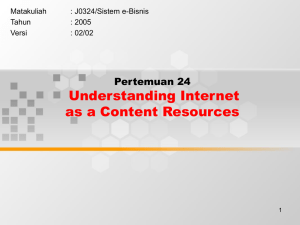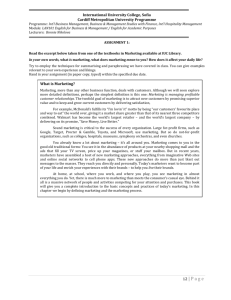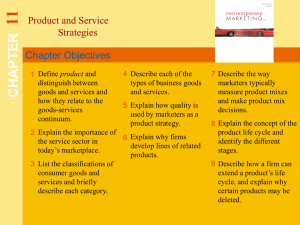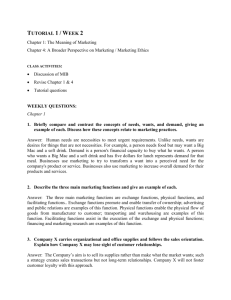Chapter 1
advertisement
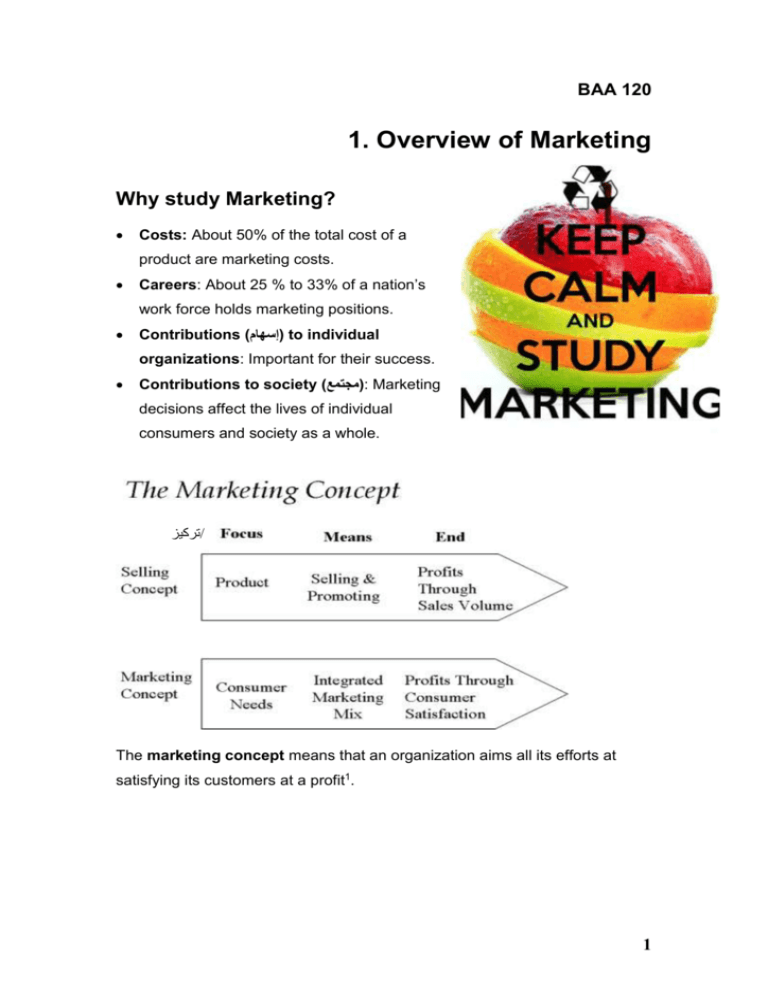
BAA 120 1. Overview of Marketing Why study Marketing? Costs: About 50% of the total cost of a product are marketing costs. Careers: About 25 % to 33% of a nation’s work force holds marketing positions. Contributions ( )إسهامto individual organizations: Important for their success. Contributions to society ()مجتمع: Marketing decisions affect the lives of individual consumers and society as a whole. تركيز/ The marketing concept means that an organization aims all its efforts at satisfying its customers at a profit1. 1 o Definition of ‘Marketing’ Marketing is the activity ()نشاط, set of institutions, and processes ()العمليات for creating ()خلق, communicating, delivering, and exchanging offerings that have value for customers, clients, partners, and society at large2. Most people believe that Marketing is the same as Advertising or Personal Selling. But this definition shows that marketing is much bigger. Core Marketing Concepts: Needs: are states of physical or mental deprivation. For example, people require ( )تطلبfood, clothing, and shelter. These are not created by society or marketers: they exist in humans. Wants: are desires for specific satisfiers of deeper needs. Shaped by culture and personal development. For example, a person needs food, but he wants to eat a burger. Demands: are wants for specific products that are backed up by an ability and willingness ( )القدرة واالستعدادto buy them. Person’s ability and willingness to buy changes over time. Example: many people want to buy BMW or Mercedes but only few are able and willing to buy one. 2 Types of demands: Negative demand: There is a demand for the product of service but most people dislike it. For example: dental work, Vaccinations, medical operation. Then, Marketers’ task is to try change consumer attitude towards their products. No demand: Customers are uninterested or have no information about the product. For example students do not know or have no interest in the Chinese language courses available in UOB. Marketers’ task is to try and create a demand by promoting their product. Latent demand: (Hidden demand) many consumers may have strong needs that cannot be satisfied by an existing product or service. It’s a gap between desirables ( )مرغوب فيهand the available. For example: the youth like to hear music using a portable music system, Sony successfully identified that hidden demand and introduced the Sony walkman. Marketer’s task is to try develop or find this demand. Falling Demand: Every organization sooner or later faces falling demand for its product or service. Marketers must analyze the cause of decline ( )هبوطand attempt to reverse this decline, or introduce another product. Irregular demand: Demand that changes on seasons, daily, or even hourly basis. 3 Full demand: happens when the organization is pleased with their volume of business. The marketer task is to maintain this level of demand. Overfull demand: while no demand is bad for an organization, having too much demand is equally damaging especially if you cannot meet this demand. Marketers use “De-marketing” to try reduce this demand temporarily or even permanently. Unwholesome demand: (Unpleasant demand) unwholesome products will attract efforts to discourage their consumption. For example cigarettes, alcohol, gambling. Marketers task is to destroy this demand, by price hikes (or TAX), or reduced availability. Marketing Mix (4Ps) These are the four controllable factors or the tools that managers organize to satisfy consumer needs and company objectives. Marketing Mix: the set of controllable tactical marketing tools - product, price, place, and promotion - that the firm blends to produce the response it wants from the target market3. Product: a good, service or idea to satisfy the consumer’s needs. It is anything tangible or intangible ()ملموسة أو غير ملموسة, offered for the attention, purchase, use, or consumption, which is capable to satisfy a need. 4 Price: What is exchanged for a product. The price that a customer pays for a product influences ( )يؤثر علىthe product’s image and likelihood of buying it. It is based on the analysis of product cost, customer need, competitive prices, and other governmental regulators. Promotion: a mean of communication between the seller and the buyer. It is a program designed to influence customers to buy the product. This program includes personal selling, advertising, publicity and public relation… Placement: a mean of getting the product into the consumer’s hands. This might include choosing channel of distributions, logistics, or even finding the right location. Figure : Elements of the Marketing-Mix that comprise a cohesive Marketing Program 1 Perrault Jr., W D, Cannon, J. P, McCarthy, E J, Essentials of Marketing , 12th edition, (International), McGraw Hill, New York, 2010. 2 See AMA website : http://www.marketingpower.com/AboutAMA/Pages/DefinitionofMarketing.aspx (retrieved on 27 Sep 2011) 3 Grewal, D., Levy, M., Marketing, second edition,. McGraw Hill- Irwin, New York ( 2007) 5

